Nearly every professional contractor uses an air compressor. Of course, it’s not just a construction tool. Automotive, woodworking, aviation, marine, and many others use compressors to power air tools. When I got our team together to decide on the best air compressor, we sparked a fierce debate concerning brands, styles, prices, and much more.
The first questions were “What size?” and “What’s the application?” Good points. The selections below are the result of many hundreds of hours of testing and use—not to mention several more hours of internal discussion! Now that the physical and relational bruises have healed, I’m ready to share our expert opinions across a range of compressor categories.
Best Air Compressors – Our Top Picks
Best Overall – Our Pro Pick
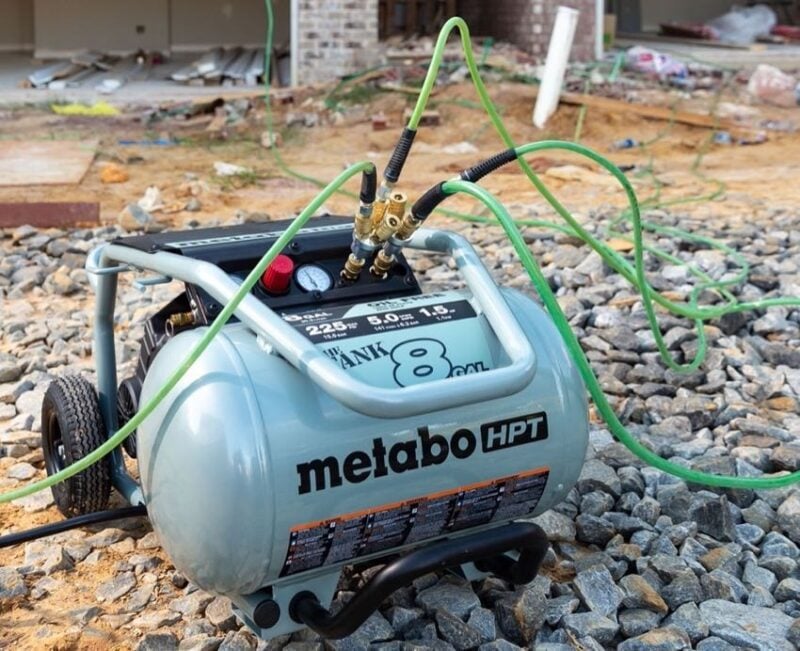
Coming off of the success of the Metabo HPT pancake air compressor (also called “The Tank”), the 8-gallon EC1315SM delivers more CFM and capacity. Max pressure is 225 PSI—which you’ll likely never use. However, what you may use is the 5 CFM (at 90 PSI) which lets you run up to 3 framing nailers or 4 roofing/siding nailers simultaneously.
Running a trim crew? Connect as many as five 15-gauge or 16-gauge finish nailers and get to work! In either of these scenarios, each tool would have plenty of air to drive nails. Another great feature is the quick ramp-up time—just 55 seconds to get from to 125 PSI from empty. When you do run it below 95 PSI, the recovery time is a brisk 14 seconds.
For the money, you get a lot in this capable package. Between the wheeled portability and capacity—this compressor is my all-around go-to workhorse on any jobsite.
Reasons to Buy
- Lots of output
- Wheeled portability
- Dual 1/4-inch NPT ports
- Connector 2 A smart tool tracking
Consider Alternatives if you…
- Truly need more volume
- Do mostly trim work
Most Compact Trim Compressor
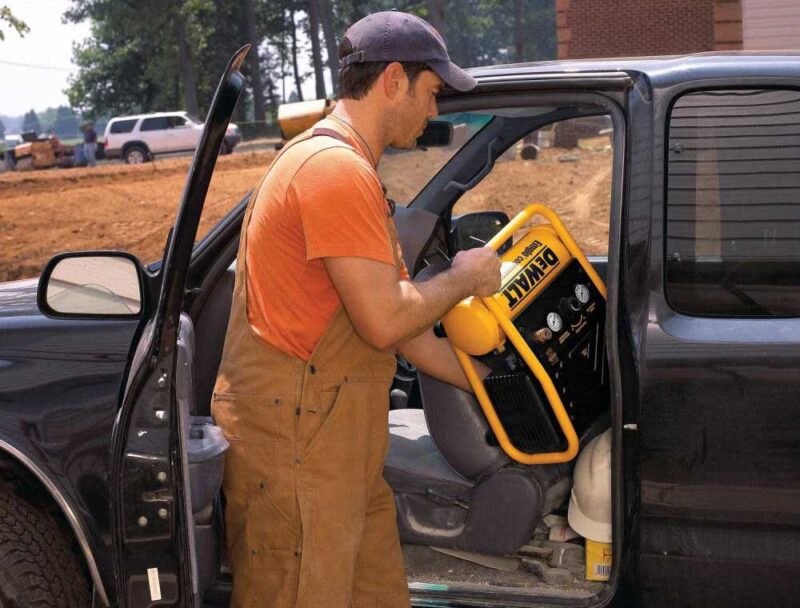
DeWalt 1-gal Trim Compressor D55140
- Capacity: 1 gallon
- Output (@90 PSI): 0.75 CFM
- Max output: 135 PSI
- Noise: 71 dBA
- Running power: 0.6 HP, 2.6A
- Weight: 24 lbs.
Choosing the best small air compressor used to mean grabbing a pancake model. Lately, however, smaller “hot dog” compressors have proven their worth on small punch lists and trim jobs. The almost unbelievably small DeWalt D55140 features a 1-gallon tank and weighs less than a Cocker Spaniel. I can stand this compressor on the rear floor of an F150 SuperCab without a second thought and get to work.
The key to enjoying this trim compressor is application. It consistently drove 18-gauge brad nailers and 23-gauge pinners without any difficulty. If you want to do some remodeling with a framing nailer, you’ll want to get a larger model (like the DeWalt 6-gallon pancake compressor or one of my other recommendations).
Lastly, the D55140 doesn’t make a ton of noise. It’s around 4-5 dBA quieter than most other trim compressors. That’s more than enough to be noticeable.
Reasons to Buy
- SUPER portable
- Lightweight
- Low current draw works on multi-use circuits
- Reasonably quiet
Consider Alternatives if you…
- Plan to run any framing or roofing/siding nailers
- Need more CFM
Quietest Portable Air Compressor
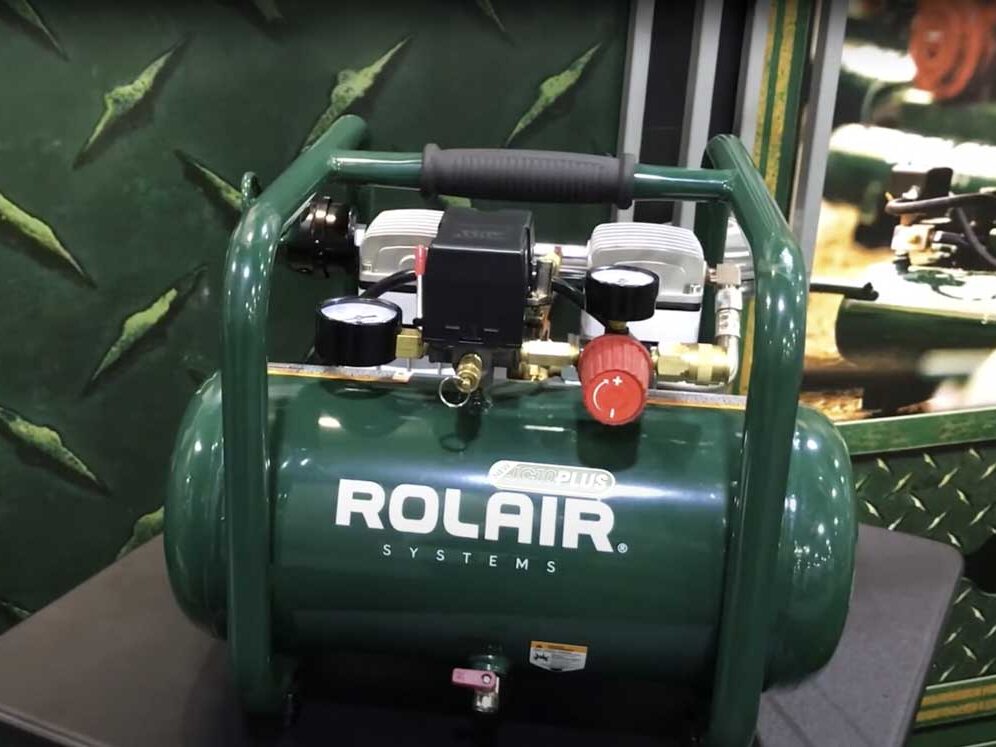
Rolair 2.5-gallon Ultra-Quiet JC10PLUS
- Capacity: 2.5 gallons
- Output (@90 PSI): 2.4 CFM
- Max output: 135 PSI
- Noise: 60 dBA
- Running power: 1.0 HP, 7.5A
- Weight: 45 lbs.
At 60 decibels, the Rolair Ultra-Quiet 2.5-gallon air compressor is quiet enough to hold a conversation next to it. As impressive as this is, the noise level represents just one of many features we liked after choosing it as the quietest portable air compressor.
The JC10PLUS offers better air delivery than most. With up to 2.4 CFM at 90 PSI, it uses a 1.0 HP motor to put out enough air to drive most framing and roofing nailers. It keeps the noise down by running at 1750 RPM with just a 7.5-amp draw on the motor. I love the roll cage, the centered rubber handle, and the fact that it weighs just 50 pounds. It’s about as portable as you can get for this capacity without putting wheels on it (which increases bulk).
Lastly, the cycle times are short—nearly identical to the larger 8-gallon Metabo HPT model that’s our overall top pick. Expect it to take around 14 seconds to get from 95-125 PSI. I also consider Rolair one of the best air compressor brands on the market, with models ranging from hand-carry models to wheeled and stationary units up to 200 gallons in size.
Reasons to Buy
- Absolutely the quietest air compressor on the market in this class
- Great mid-level capacity that works well for almost any job
- Quick recovery time
Consider Alternatives if you…
- Don’t want to hear your coworkers!
- Need more capacity and CFM for roofing applications
Best Cordless Air Compressor
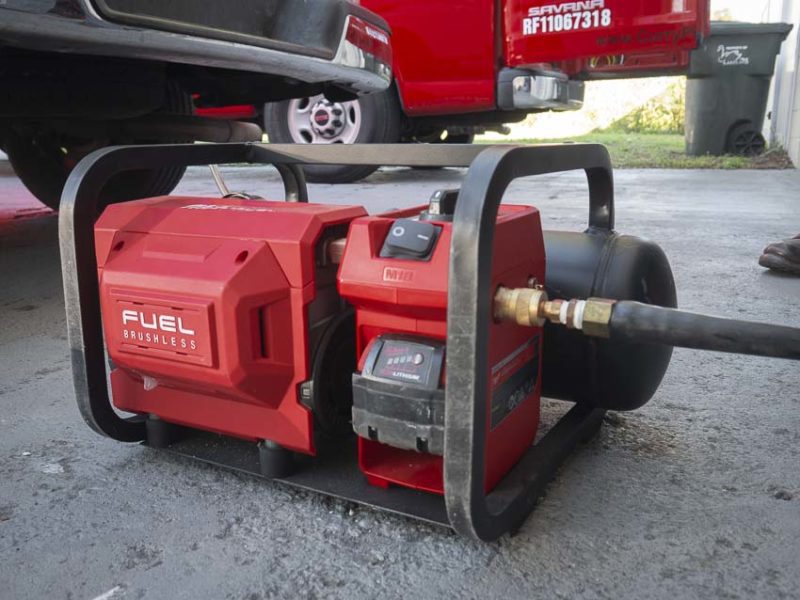
Both the DeWalt FlexVolt and Milwaukee cordless compressors make solid cordless compressors and carry similar specs. However, the 2-gallon Milwaukee earns the nod for several reasons. First, it’s a full 11 decibels quieter (just 68 dBA). Audibly, that sounds about half as loud as the DeWalt! It does trade a bit of that for weight, however.
While it’s certainly helpful on jobsites with no power, our plumbing pro also successfully used it to bleed heaters (which typically have to be done manually) and air-test PEX on several re-pipes. It even worked to pressure test a new sewer line.
You get a very respectable 1.2 SCFM at 90 PSI—about what you could expect from a capable corded trim compressor. The roll cage’s carry handle (and good balance) are the cherry on top. A bit pricey at $379 as a bare tool, I still like the portability and performance for professionals. This compressor also earned a 2020 Pro Tool Innovation Award.
Reasons to Buy
- Perfect tool for converting manual pressure tests to automatic
- Excellent output for trim applications and framing/roofing/siding punch lists
Consider Alternatives if you…
- Need 150 PSI or more
- Want more capacity before recovery kicks in
Best Shop Compressor
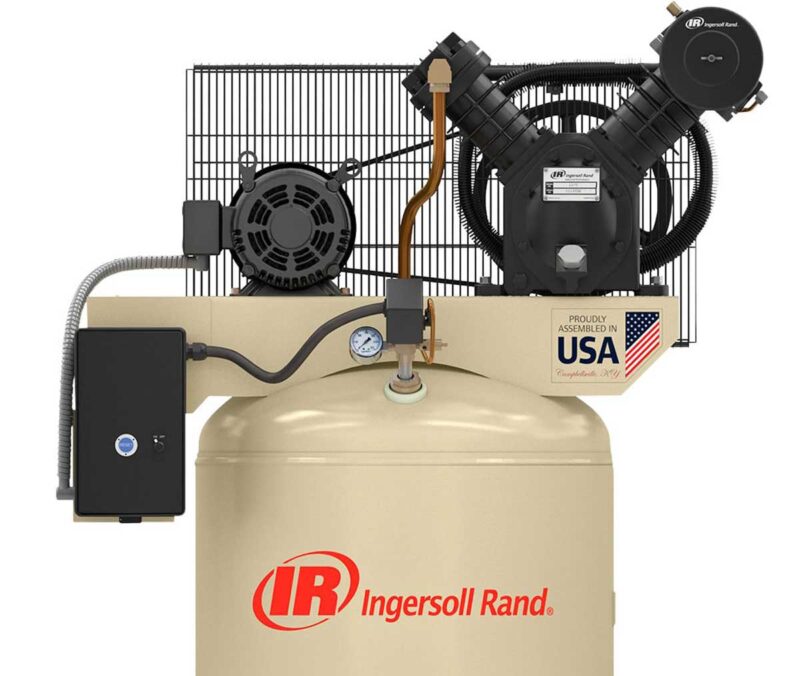
Ingersoll Rand 80-gal 7.5 HP 1P 2475N
- Capacity: 80 gallons
- Output (@90 PSI): 17.2 CFM
- Max output: 175 PSI
- Noise: 85 dBA
- Running power: 5.0 HP, 28A
- Weight: 500 lbs.
Things got heated when we started talking about the best shop compressor. One thing is clear: Ingersoll-Rand, Jet, and Rolair dominate the shop compressor space in the opinion of our review team. Either of those brands represents a solid choice.
The Ingersoll-Rand 2475N stands out as it offers 100% duty cycle operation with 17.2 CFM at 90 PSI. (IR has models that go up to 24 CFM or more). This single-phase compressor also installs easily into any garage with an available 230V circuit. Commercial shops can look at the 3-phase model.
This is a premium product for any shop looking to drive sanders, lifts, and multiple impact wrenches or other air tools simultaneously. At $3149, expect to pay for the quality you get with this system.
Reasons to Buy
- You want a premium product for your home shop
- You operate multiple high-CFM tools at the same time
Consider Alternatives if you…
- Don’t need this much continuous airflow
- Run a commercial shop with 3-phase power
- Want a more economical choice on a budget
Editor’s Note: Be sure to also check out our recommendation for the best portable air compressor for your home garage
Best Air Compressor for the Money
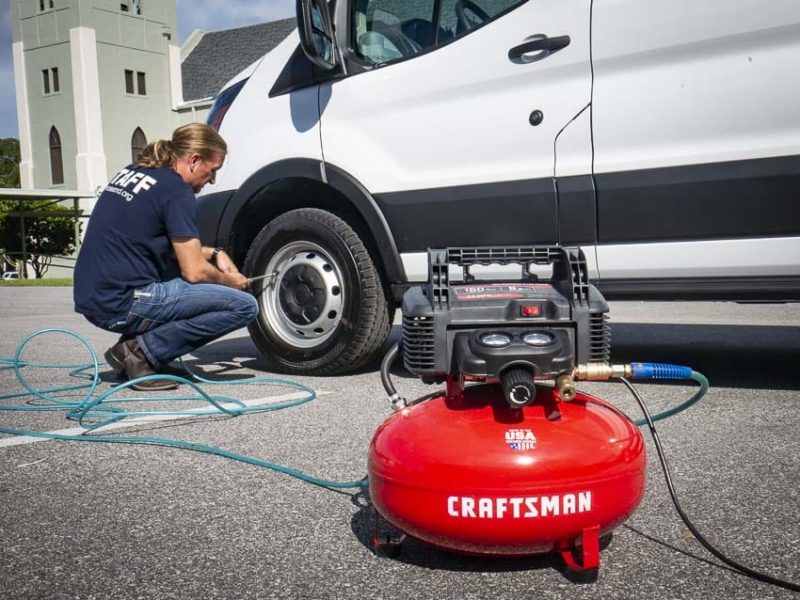
Craftsman CMEC6150 6-gal
- Capacity: 6 gallons
- Output (@90 PSI): 2.6 CFM
- Max output: 150 PSI
- Noise: 78.5 dBA
- Running power: 0.8 HP
- Weight: 30 lbs.
Priced around $129, this Craftsman 6-gallon pancake compressor lets you tackle anything from framing to trim tasks. It delivers up to 120 PSI pressure consistently (150 PSI max) with airflow of 2.6 SCFM at 90 PSI. The oil-free design should let you use this for many years with little to no maintenance. For those keeping score, the fact that this product is manufactured in the USA makes it even better.
We tested this product on managing a small fleet of vehicles for a local non-profit ministry as well as with smaller trim jobs and limited framing applications and punch lists. The 6-gallon capacity really helps when you have a small project involving higher-demand air such as roofing. The fact that I could run a couple of tools at once without a splitter just adds to the appeal of this inexpensive tool.
Reasons to Buy
- You want a capable inexpensive compressor
- Work primarily involves DIY, punch lists, or trim
Consider Alternatives if you…
- Require more CFM for roofing or siding
- Want to run air sanders or operate multiple framing or roofing nailers simultaneously.
Our Process and the Nitty Gritty
Why You Can Trust Pro Tool Reviews
Ever check out a “review” site and you can’t tell if they actually tested the tools or if they’re just “recommending” the Amazon top sellers? That’s not us. We only recommend what we’d actually use, even if we don’t earn a commission from it. It’s all about giving you a legitimate recommendation and our honest opinion of each product.
Since 2008, Pro Tool Reviews has been writing reviews and reporting on industry news in the construction, automotive, and lawn care industries. Our Pro reviewers work in the trades and have the skills and experience to know whether tools can perform well in the field.
We also work with dozens of professional contractors around the United States who review products for us on real jobsites and consult with us on testing methods, categories, and weighting. We’ll provide more than 500 pieces of new content this year absolutely free for our readers.
The result is information you can trust because of the editorial, scientific, and real-world professional experience we collectively utilize every time we pick up and test a tool.
More Compressors We Recommend
Kobalt 26-gal Vertical Air Compressor
I reach for Kobalt when looking for an inexpensive but quality compressor in just about any form factor. Found at Lowe’s, their larger-capacity 26-gallon vertical compressor offers up 4.5 CFM at 90 PSI. The supplies enough air for many sanding and air tool applications. Add to that the low price and you have a solid stationary compressor pick for your shop or garage.
Metabo HPT Tank XL Wheelbarrow Compressor
Metabo HPT simply nailed the design of their 9-gallon Tank XL wheelbarrow air compressor. Powered by a Honda GX160 engine, it oozes long-term reliability. With a pair of 4.5-gallon tanks, it delivers 9.5 CFM at 90 PSI—dropping only slightly to 9.3 CFM at 100 PSI. That’s plenty of CFM to run 4-5 roofing nailers at one time…rapid-fire. From start to finish, I believe Metabo HPT makes the all-around best wheelbarrow air compressor.
Porter Cable C2002 150 PSI Oil-Free Pancake Compressor
Porter Cable C2002 is basically a clone of the Craftsman CMEC6150 but with a $20 premium. This solid, budget-friendly air compressor supplies enough air for DIY and entry-level pro trim and minimal framing use. I like the 6-gallon capacity and 2.6 CFM airflow rate at 90 PSI. A great all-around tool for the DIYer or Pro on a budget.
Ridgid 4.5-gal Quiet Air Compressor
This dual-stack electric air compressor provides up to 5.1 CFM at 90 PSI. This alone makes it a great solution for running a couple of framing or roofing nailers and even has some use for certain sanding applications. The 77 dBA noise rating makes it quieter than many, but other models produce less sound if that’s your top priority.
Ryobi 18V 1-gal Cordless Air Compressor Kit
This basic but versatile 1-gallon cordless air compressor provides up to 120 PSI and is perfect for DIY light-duty use and trim projects. If you’re already on the Ryobi 18V tool platform, then opt for the $179 tool-only model. With 0.5 CFM at 90 PSI it won’t run more than a single trim tool efficiently, but it still gives you a very portable (just 14 pounds) solution for the jobsite or DIY projects.
Air Compressor Buying Guide
Power Source
The most common air compressors run on either gas or electric power. Electric models run at either 120V or 240V, depending on the level of performance they have. I prefer electric for its simplicity of use and you’ll note that I didn’t make many gas picks in this list.
Gas units are usually reserved for jobs that require high air delivery when mobility is a priority. Certain wheelbarrow compressors come to mind.
Battery-powered air compressors are becoming more popular with several major power tool brands making them. These are typically lower-power options that are best for finish nailers and other low-supply applications.
CFM and PSI
When shopping for an air compressor, CFM and PSI are the key specs. They tell you the most about the performance you can expect.
CFM (often measured at 90 PSI) lets you know the volume of air the unit can sustain at a particular pressure. You can get higher CFM out of the tanks, but the pump won’t be able to replace it as fast as you’re using it. That means you have to take some “breaks”. Some tools, such as finish nailers, require very little CFM to keep up with the pace of the work. Other tools, like air sanders, need much higher CFM values to keep running.
PSI (pounds per square inch) is a measurement of the maximum pressure the pump can put in the tank. The higher the pressure, the greater the amount of air the tank can hold. 125 PSI is a good starting point and 200 PSI gets you into the high end of the spectrum for the most common units. On the output side, most nailers, ratchets, and sanders require 90-100 PSI.
The reality is that every tool has its own CFM and PSI requirements. Check the package or the manual for the tool you’re considering and make sure the air compressor you’re buying handles both. To make sure you get the most from your compressor, we recommend going with a model that gives you 50% higher CFM than your highest tool’s needs.
Pro Tip: Drain your air compressor after every use. The air that comes in carried moisture with it and can start to rust the tank from the inside, especially around coastal areas.
Size (Capacity) and Style
Before choosing an air compressor, decide whether you need portability, capacity, or a mix of both. Compressors come with tank sizes ranging from 1 gallon to 200 gallons. The tank combines with the maximum PSI to determine how much compressed air it can deliver before the motor has to “recycle” more air, compressing it and sending it back into the tank.
Smaller electric compressors are highly portable. They can run on a generator if you don’t have a direct AC power supply nearby. On the other hand, larger units tend to be installed in place with air piped to the most convenient locations where you install connectors for your hoses.
Even if you find your compressor’s tank capacity is a little low, you can add a reserve tank to increase it.
Pro Tip: Every tank has an expiration date. Replace it once you reach that date to ensure the tank doesn’t fail.
Couplers
Most portable air compressors have one or two couplings on board. It’s also possible to add a two or three-way splitter. Just be aware that you’re sharing the air and your system needs to work harder to keep up.
Noise Level
Air compressors can be noisy! Add in a small gas engine and they get loud enough that you’ll want hearing protection.
One way to reduce noise is with the drive style. Belt drive compressors run quieter than direct drive by nature.
If you frequently work indoors, in occupied spaces, or around noise-sensitive campuses, look for a quiet compressor. These can drop down below 60 decibels (though most are more) and operate at a level you can actually hold a conversation next to.
Most quiet models are on the lower air delivery side. That means you’re unlikely to find one that’s good for sanding or roofing.
Duty Cycle
Duty cycle is a rating that tells you the percentage of time your compressor can run. For example, a 50% duty capacity tells you it needs 30 minutes of downtime for every 30 minutes of running.
If you’re looking for the best model in a high-use environment, check the rating. Look for a compressor with a 100% duty cycle for high-demand work. For work that doesn’t keep a compressor working to keep up the entire time (most common), a 50% duty cycle is just fine.
Some air compressors can run continuously with a particular amount of airflow guaranteed at the outlet. You find these in industrial applications and they typically use what’s known as a rotary-screw design. The other kind of continuous duty design involves air supply underwater and for similar applications where a steady flow of air is required from a more portable design.
Pump Type
Without going into a ton of detail about air compressor pumps, there are two basic types: oiled and oil-free. Oil-free models are much more convenient since you don’t have to worry about oil levels and require less maintenance.
Don’t be afraid of splash-lubricated compressors, though. They don’t require a ton of refilling even though you should keep an eye on the levels frequently. In the end, your best bet is the compressor that meets your tools’ requirements whether it needs oil or not.
Types of Air Compressors
We mention several different types of air compressors above. If you’re shopping for your first one, here’s a breakdown of what we mean:
Pancake Air Compressor
Pancake air compressors use a round, flatter tank style with the motor and pump on top. They’re highly portable and stable with a relatively small footprint. These are a favorite among trim carpenters but I also see a lot of roofers using them due to some models including higher CFM ratings.
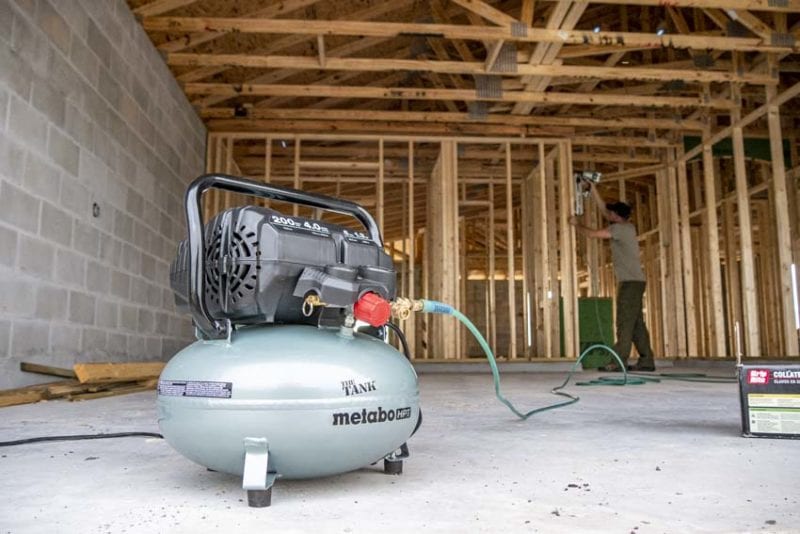
Hot Dog Air Compressor
A “hot dog” air compressor uses a single, longer cylinder-shaped tank with the motor and pump up top. Smaller capacity models are similar in footprint to pancake designs while larger capacities tend to take up more room. Some models may include a wheel system built into the frame. Tank sizes vary on these but generally, they fall between 1 and 5 gallons.
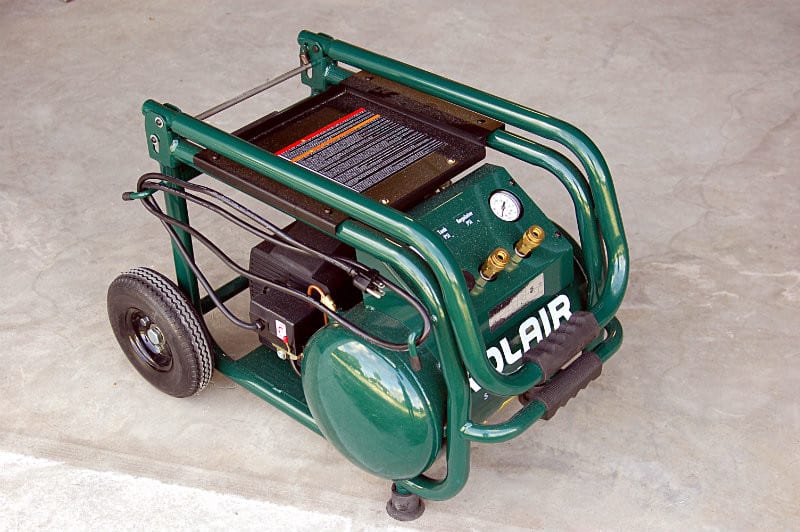
Twin Stack Air Compressor
Essentially, a twin-stack air compressor features a double hot dog style. The two tanks can be on the base or stacked on top of one another with the motor and pump shifting from the top to the front side. The advantage is primarily additional capacity. Some models will have a wheel and handle system built into the frame.
Wheelbarrow Air Compressor
Take a twin-stack air compressor and expand it, and you get a wheelbarrow compressor. These usually feature two high-capacity tanks on the base with a gas engine for its power plant (there are also electric models). A single wheel between the tanks and handles on the opposite side makes it portable despite its much heavier design.
Vertical Air Compressor
Vertical air compressors use a single high-capacity tank with the motor and pump mounted on top. Smaller models usually have a handle and wheels that you can move around similar to a hand truck. Larger models are designed to be installed and stay in place.
